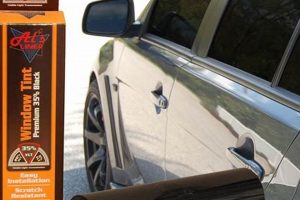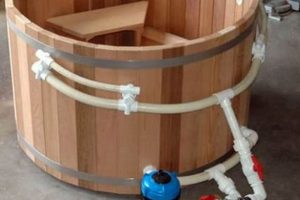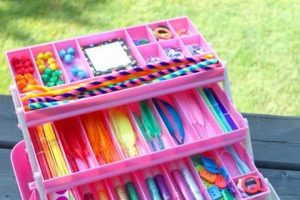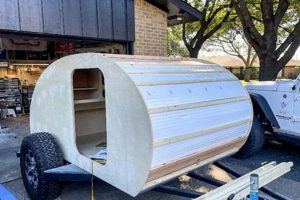A self-assembly package containing the necessary components and instructions for constructing a sauna is a specific type of product in the home improvement market. These packages typically include pre-cut lumber, a heating unit, a door, benches, and hardware required for assembly. An example would be a package containing cedar planks, a wood-burning stove, and detailed diagrams allowing a homeowner to build a functional sauna in their backyard.
The increasing popularity of constructing a sauna using a pre-packaged set stems from several factors. It offers a cost-effective alternative to hiring professional contractors for complete sauna construction. The kits provide a degree of customization, enabling individuals to tailor the sauna’s design and features to their preferences. Historically, self-built saunas have been a feature of various cultures, and this approach offers a modern iteration of that tradition.
The subsequent sections will delve into the key considerations for selecting a suitable package, examine the necessary skills and tools required for successful assembly, and provide a comprehensive overview of the construction process. This will also address potential challenges and safety precautions necessary for a successful project.
Tips for Selecting and Assembling a Sauna Construction Package
The successful assembly of a sauna using a pre-packaged set relies on careful planning and execution. The following guidelines provide essential considerations for ensuring a safe and functional final product.
Tip 1: Assess the Available Space: Measure the intended location precisely. Compare these measurements with the package dimensions to guarantee adequate clearance for both construction and operation. An example would be ensuring sufficient space for the door swing and proper ventilation.
Tip 2: Review the Package Contents: Thoroughly inspect the components upon delivery. Verify that all items listed in the inventory are present and undamaged. Discrepancies should be reported immediately to the supplier to avoid delays during assembly.
Tip 3: Evaluate Heating Unit Options: Consider the type of heating unit included. Electric heaters offer ease of use and temperature control, while wood-burning stoves provide a traditional sauna experience. Select the unit that aligns with usage preferences and safety regulations.
Tip 4: Understand Ventilation Requirements: Adequate ventilation is crucial for safety and comfort. Confirm that the package design incorporates proper air intake and exhaust vents. Adjustments may be necessary based on local building codes.
Tip 5: Study the Assembly Instructions: Read the instructions completely before commencing assembly. Pay close attention to diagrams and specific warnings. A thorough understanding of the process will minimize errors and potential hazards.
Tip 6: Ensure Proper Electrical Connections: If the package includes an electric heater, ensure that electrical connections are performed by a qualified electrician. Compliance with local electrical codes is essential to prevent electrical hazards.
Tip 7: Apply Proper Sealing and Insulation: Use appropriate sealant to prevent moisture penetration and heat loss. Proper insulation will improve energy efficiency and maintain consistent temperatures within the sauna.
Careful adherence to these guidelines enhances the likelihood of a successful sauna construction and provides a safe and enjoyable sauna experience. By focusing on planning, preparation, and safety, potential challenges can be mitigated.
The subsequent article sections will address specific construction challenges and maintenance procedures for ensuring the longevity and optimal performance of the sauna.
1. Material Quality
The selection of materials in a pre-packaged sauna assembly set is a paramount determinant of the final product’s durability, performance, and safety. Compromises in material grade can lead to structural weaknesses, reduced thermal efficiency, and potential health hazards.
- Wood Species Selection
The choice of wood species directly impacts heat retention, resistance to moisture, and longevity. Cedar, redwood, and hemlock are commonly favored for their natural resistance to decay and their ability to withstand high temperatures. Inferior wood types may warp, crack, or emit harmful compounds under sauna conditions, compromising the user experience and potentially posing health risks.
- Lumber Grading and Treatment
The grading of lumber dictates its structural integrity. Clear, knot-free lumber is preferred for its strength and resistance to warping. Pressure-treated lumber, while durable, may contain chemicals that off-gas under high heat, making it unsuitable for sauna interiors. Proper kiln-drying processes minimize moisture content, reducing the likelihood of warping and cracking over time.
- Hardware Composition
Fasteners, hinges, and other hardware components must be constructed from materials resistant to corrosion and high temperatures. Stainless steel and brass are common choices for their durability and resistance to rust. Substandard hardware can fail under stress, compromising the structural integrity of the sauna and posing safety hazards.
- Heating Unit Materials
The heating unit’s material composition impacts its efficiency and safety. High-quality heating elements are constructed from corrosion-resistant alloys designed to withstand repeated heating and cooling cycles. Inferior materials may corrode or fail prematurely, leading to uneven heating or potential fire hazards.
The integration of superior materials directly influences the overall value and lifespan of a self-assembled sauna. While cost considerations may influence material selection, prioritizing quality ensures a safer, more efficient, and enduring sauna experience. Using a lower grade material can save money upfront, but end up costing more over time with replacement and repairs.
2. Structural Integrity
The structural integrity of a sauna constructed from a self-assembly package is a paramount concern directly affecting user safety and the longevity of the structure. Compromises in structural soundness can lead to instability, collapse, and potential injury. The materials and assembly methods stipulated within the package directly dictate the final structural reliability. For instance, a kit employing insufficient lumber dimensions or inadequate joint connections is likely to exhibit weakness under stress, particularly with the added load of users and temperature fluctuations inherent in sauna operation. A real-world example is a poorly constructed sauna roof failing under snow load, resulting in significant damage and potential hazard to occupants. Therefore, thorough adherence to construction guid
elines and the proper selection of materials are essential to mitigating these risks.
Further considerations include the foundation upon which the sauna is built. A non-level or unstable foundation will introduce stress points within the structure, accelerating wear and tear and potentially leading to structural failure. The type and placement of fasteners, such as screws or nails, also play a critical role. Insufficient or improperly installed fasteners can weaken joints and compromise the overall stability of the sauna. Furthermore, the design of the sauna itself can influence its structural integrity. A design lacking adequate cross-bracing or support beams may be inherently weaker than one incorporating these features. In practical application, this means carefully examining the kit’s specifications to ensure it meets or exceeds local building codes for structural requirements.
In summary, maintaining the structural integrity of a sauna kit is not merely a matter of aesthetics but a crucial aspect of safety and durability. Challenges arise from variations in material quality and the inherent complexities of self-assembly, emphasizing the need for meticulous attention to detail and a thorough understanding of basic construction principles. A structurally sound sauna provides a safe and enjoyable experience, while a compromised structure presents significant risks, underscoring the practical significance of this understanding.
3. Heating System
The heating system is an indispensable component of any self-assembled sauna, directly influencing the user experience, operational costs, and safety profile. The choice of heating system within a “sauna kit diy” scenario dictates the heat-up time, temperature consistency, and overall efficiency of the sauna. For example, an undersized heater will struggle to achieve the desired temperature, leading to prolonged preheating times and potential user dissatisfaction. Conversely, an improperly installed or maintained heater poses a significant fire risk, underscoring the critical need for careful selection and adherence to installation guidelines. The type of heating system (electric, wood-burning, or infrared) further shapes the nature of the sauna experience. Electric heaters offer convenience and precise temperature control, while wood-burning stoves provide a traditional ambiance and potentially lower operating costs in areas with readily available firewood.
The integration of the heating system into the “sauna kit diy” necessitates careful consideration of several factors, including power requirements, ventilation needs, and safety clearances. Electric heaters require dedicated electrical circuits and grounding to prevent electrical hazards. Wood-burning stoves demand proper venting to exhaust smoke and carbon monoxide safely. Regardless of the heating system type, adherence to local building codes and manufacturer’s instructions is paramount. An example of a successful integration is a kit that provides pre-cut ventilation openings and clear instructions for wiring an electric heater, simplifying the assembly process and reducing the risk of errors. Conversely, a poorly designed kit lacking adequate safety features or unclear instructions can lead to dangerous and potentially life-threatening situations.
In summary, the selection and installation of the heating system represent a critical juncture in the “sauna kit diy” process. This decision influences not only the functionality of the sauna but also its long-term operational costs and safety profile. Understanding the nuances of different heating system types, adhering to safety guidelines, and ensuring proper installation are essential for a safe and enjoyable sauna experience. The heating system should align to electrical standards to prevent over current and fire hazards.
4. Ventilation Design
Ventilation design is an intrinsic element of sauna construction, directly impacting air quality, user comfort, and structural longevity. Within the context of self-assembled sauna packages, adequate ventilation mitigates the risks associated with heat and moisture accumulation, contributing to a safer and more enjoyable sauna experience.
- Air Intake Placement
The strategic placement of air intakes is crucial for ensuring a continuous supply of fresh air. Typically located near the floor and adjacent to the heater, intakes facilitate convective airflow, drawing cooler air in to replace the rising hot air. Inadequate placement can result in stagnant air pockets and an uneven distribution of heat, exemplified by stuffiness in the lower portion of the sauna.
- Exhaust Vent Positioning
The positioning of exhaust vents is equally critical for expelling stale, moisture-laden air. Ideally situated near the ceiling on the opposite side of the heater, exhaust vents facilitate the removal of hot, humid air, preventing condensation buildup and promoting a consistent air exchange rate. Insufficient exhaust ventilation can lead to mold growth and structural damage, reducing the sauna’s lifespan.
- Ventilation Rate Calculation
Determining the appropriate ventilation rate is essential for maintaining optimal air quality. The ventilation rate, measured in air changes per hour (ACH), should be calculated based on the sauna’s volume and occupancy. An inadequate ventilation rate can result in elevated carbon dioxide levels and reduced oxygen content, leading to discomfort and potential health risks. Conversely, excessive ventilation can lead to heat loss and increased energy consumption.
- Material Permeability Considerations
The permeability of the materials used in the sauna’s construction influences the effectiveness of the ventilation system. Impermeable materials, such as vapor barriers, can trap moisture within the walls and ceiling, promoting mold growth. Conversely, highly permeable materials can allow excessive moisture penetration, reducing the sauna’s thermal efficiency. A balance between permeability and insulation is necessary to ensure optimal performance and longevity.
The integration of these ventilation design elements is critical for maximizing the benefits and minimizing the risks associated with self-assembled saunas. Variations in kit designs necessitate a thorough understanding of ventilation principles to ensure a safe, comfortable, and structurally sound final product. Prioritizing ventilation contributes to prolonged sauna life.
5. Safety Compliance
Safety compliance constitutes a fundamental aspect of sauna construction, particularly when considering self-assembly packages. Adherence to established safety standards and regulations is essential to mitigate potential hazards associated with high temperatures, electrical components, and structural integrity. The absence of rigorous compliance measures can lead to increased risk of fire, electrical shock, burns, and structural failure.
- Electrical Safety Standards
Compliance with electrical safety standards is paramount when installing electrical heating units. This encompasses adherence to the National Electrical Code (NEC) or equivalent regional standards, ensuring proper wiring, groundi
ng, and circuit protection. Failure to comply with these standards can result in electrical shock or fire hazards, particularly in the humid sauna environment. Example: Using appropriately rated wiring and employing Ground Fault Circuit Interrupters (GFCIs) to prevent electrical leakage. - Building Code Adherence
Sauna construction must align with local building codes, which dictate requirements for structural integrity, ventilation, and fire resistance. These codes vary by jurisdiction and address critical aspects such as ceiling height, door swing direction, and emergency egress. Non-compliance can result in code violations, potential fines, and, more importantly, compromised safety. Example: Ensuring adequate ceiling height to prevent overheating and installing a door that opens outward for rapid egress.
- Heating Unit Certification
The heating unit employed within the sauna must possess certification from recognized testing laboratories, such as UL or ETL. Certification indicates that the unit has undergone rigorous testing to ensure it meets safety standards for performance, electrical safety, and fire resistance. Employing uncertified heating units increases the risk of malfunction and potential hazards. Example: Verifying that the heating unit displays a valid certification label and complies with specified power requirements.
- Material Safety and Off-Gassing
Materials used in sauna construction should be selected to minimize off-gassing of volatile organic compounds (VOCs) at elevated temperatures. Certain wood treatments, adhesives, and sealants can release harmful chemicals when heated, posing a health risk to sauna users. Using natural, untreated lumber and low-VOC finishes mitigates these risks. Example: Selecting cedar or redwood, known for low VOC emissions, and avoiding pressure-treated lumber containing potentially harmful chemicals.
The multifaceted nature of safety compliance underscores its importance in “sauna kit diy”. Failure to prioritize safety can transform a potentially beneficial relaxation space into a source of significant risk. Adherence to established standards, proper material selection, and meticulous assembly are essential for ensuring a safe and enjoyable sauna experience.
Frequently Asked Questions
The following questions address common concerns and misconceptions regarding the assembly and operation of saunas constructed from pre-packaged kits. These answers aim to provide clarity and ensure safe and effective utilization.
Question 1: Are specialized tools required for sauna assembly?
While the specific tool requirements vary depending on the kit’s design, certain tools are generally necessary. These typically include a level, measuring tape, drill, saw (circular or hand saw), hammer, and safety glasses. More complex kits may necessitate specialized tools such as a nail gun or a miter saw for precise cuts. Consult the kit’s instruction manual for a comprehensive list of required tools.
Question 2: How long does it typically take to assemble a sauna kit?
The assembly time depends largely on the size and complexity of the sauna, as well as the individual’s skill level and experience. A small, pre-cut sauna kit can typically be assembled in one to two weekends by someone with basic carpentry skills. Larger or more complex kits may require several days or even weeks to complete. It is advisable to allocate ample time and enlist assistance if necessary.
Question 3: What type of foundation is required for a sauna kit?
The foundation requirements vary depending on the sauna’s design and the intended location. A solid, level foundation is essential for ensuring the sauna’s structural integrity. Common foundation options include a concrete slab, gravel base, or a wooden platform. The foundation must be capable of supporting the weight of the sauna and its occupants, and it must be properly drained to prevent moisture accumulation.
Question 4: What are the electrical requirements for a sauna heater?
Electrical sauna heaters require a dedicated electrical circuit with the appropriate voltage and amperage rating. The specific electrical requirements will be specified in the heater’s installation manual. It is crucial to engage a qualified electrician to install the electrical wiring and connections, ensuring compliance with local electrical codes and preventing potential hazards.
Question 5: How is proper ventilation achieved in a sauna kit?
Proper ventilation is essential for maintaining air quality and preventing moisture buildup. Sauna kits typically include pre-cut ventilation openings or instructions for creating them. These openings should be strategically positioned to ensure adequate airflow throughout the sauna. The intake vent should be located near the floor, and the exhaust vent should be located near the ceiling on the opposite side of the heater.
Question 6: What maintenance is required for a sauna kit?
Regular maintenance is essential for prolonging the life of a sauna and ensuring its safe operation. This includes cleaning the interior surfaces regularly with a mild detergent and water, inspecting the heater for any signs of damage or corrosion, and ensuring that the ventilation system is free of obstructions. Periodic re-staining or sealing of the wood surfaces may also be necessary to prevent moisture damage.
In conclusion, careful planning, diligent assembly, and adherence to safety guidelines are paramount for a successful and enjoyable experience with constructing a sauna from a pre-packaged set. Addressing these frequently asked questions provides a solid foundation for navigating the process effectively.
The subsequent article section will explore advanced troubleshooting tips and modifications for enhancing the performance and longevity of the constructed sauna.
Sauna Kit DIY
The preceding analysis has elucidated various facets of the “sauna kit diy” market, emphasizing key considerations ranging from material selection and structural integrity to heating system functionality and safety compliance. The responsible and informed implementation of these elements is paramount for achieving a functional and enduring sauna structure.
Prospective builders are urged to approach the construction of a sauna with diligence and a commitment to safety standards. Thorough planning, meticulous execution, and adherence to established guidelines are essential for realizing the potential benefits of constructing a personal sauna. Ignoring these factors increases the risk of compromised structural integrity, diminished operational efficiency, and potential safety hazards. Therefore, investing the necessary time and resources in proper planning and execution ensures a worthwhile and safe long-term investment.







